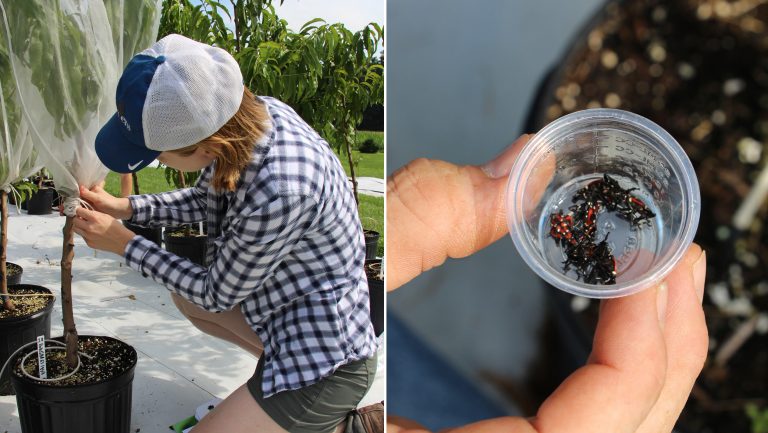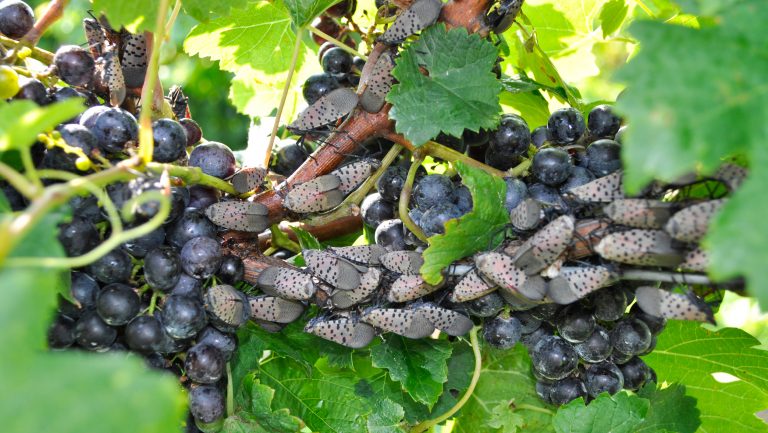Heather Leach, a public outreach extension associate in the Department of Entomology at Penn State University in University Park, does not mince words when discussing the spotted lanternfly, an invasive insect that has ravaged Pennsylvania’s vineyards. “It’s not a matter of if it’ll spread to other states,” says Leach, who is an expert on the spotted lanternfly. “It’s a matter of when.”
The spotted lanternfly (SLF)—which is indigenous to China and countries of Southeast Asia—was first detected in Pennsylvania in 2014 and has since grown in number to significantly threaten the state’s agricultural industries. With brown-gray spotted top wings, and lower wings distinguishable by their shock of red coloring, the pest is noted for its size and penchant to swarm, particularly on the more than 70 plants and trees it feeds on. Specifically, it consumes the sap of hardwoods, orchard fruit trees, hop plants, and grapevines. Not only is the spotted lanternfly a voracious eater but its excrement—euphemistically dubbed honeydew, which can develop into sooty mold—can severely damage crops in a short time, according to continuing research published by Penn State.
To date, 14 of 67 Pennsylvania counties are under quarantine to prevent the spread of the lanternfly, but sightings of the bug have been reported in Delaware, Virginia, New Jersey, and New York. Midwestern states, including Michigan and Indiana, are warning their agricultural industries about the growing threat and are looking to Pennsylvania to see how the infestation develops. Some growers have reported a loss of grapevines of 90 percent or more—in one case about 40 acres, says Leach. “A small handful of spotted lanternflies aren’t going to do that much damage,” she says. “A large population, though, will induce vine death or collapse, so the vine won’t produce fruit.”

Don’t miss the latest drinks industry news and insights. Sign up for our award-winning newsletters and get insider intel, resources, and trends delivered to your inbox every week.
What’s at stake? Pennsylvania is the fifth-largest producer of wine grapes in the U.S., and the third-largest producer of juice grapes, adding $4.8 billion to the local economy, according to trade group WineAmerica. Beyond the wine industry, the state’s production of small fruit is valued at more than $100 million; Pennsylvania is the fourth-largest producer of apples in the country—businesses in the affected counties will be severely curtailed if they cannot participate in the export market. Pennsylvania is currently the number one battleground for SLF, says Leach, but other states would do well to pay attention.
During a Pennsylvania state senate joint hearing on the economic effects of the spotted lanternfly in 2017, Calvin Beekman, of Beekman Orchards in Washington Township, testified about lost tonnage in his vineyards. At the time, Beekman had 70 acres of vineyards, averaging about 4.5 tons of grapes an acre, but the spotted lanternfly changed that, destroying about 90 percent of his grape-growing business. According to Leach, Beekman is now exploring other crops—ones that aren’t part of the spotted lanternfly’s preferred diet.
Leach and other researchers are still learning about the bug and how it affects grape production, photosynthesis, and sugar and nitrogen levels, but “we’re working under artificial conditions,” she says. Since many vines have been destroyed, and grape growers don’t want to risk their remaining vineyards, finding a research vineyard has been difficult. Penn State researchers have recently begun working with a grower who offered Riesling vines for research.
In New York State, “we’ve only encountered individual sightings of the spotted lanternfly,” says Hans Walter-Peterson, a viticulture specialist at Cornell University’s Finger Lakes Grape Program. “We currently have no knowledge of populations, but it’s only a matter of time.”
Strategies for Combating the Spread of SLF
The spotted lanternfly produces only one generation a season, and flocks to orchards and vineyards in the fall. The insect’s preferred host is the ailanthus, or tree of heaven, itself an invasive species, says Walter-Peterson. “There are pockets of tree of heaven plants around vineyards, and they can’t just be cut down,” he says, because of the plant’s robust rooting system and tendency to resprout. “Encouraging growers to learn about these plants and control their growth will help with controlling spotted lanternfly populations.”

Quarantines and public education are, for now, key steps in fighting the spread of the bug, says Leach. “People who travel through Pennsylvania need to be aware of their surroundings,” she says. “Lanternfly eggs can be laid on vehicles and shipping trucks and will [be transported] to that final destination. Check your vehicle before leaving a quarantine zone.”
If you do see egg masses, they can and should be removed. Found on smooth surfaces or on the bark of trees, masses can look like grey-tan crackly splotches of mud. Sticky tree bands placed on trees near populations of immature spotted lanternflies can also act as a check on their spread.
Walter-Peterson also points to insecticides that have recently been approved for use in fighting the lanternfly, but “we don’t want to just be using chemicals on these things,” he cautions. “It’s going to take a multipronged approach,” and pesticides may damage fruit. “We’re also looking,” he says, “for natural predators or microbes that can help manage them.”
To that end, two Cornell University scientists have made headway on research about organisms that may be a potential deterrent to the insects. In their USDA-funded study, “A pair of native fungal pathogens drives decline of a new invasive herbivore,” Eric Clifton, a postdoctoral researcher, and Ann Hajek, a professor of entomology, found that the naturally occurring fungi Batkoa major and Beauveria bassiana can greatly reduce lanternfly populations. In and around orchard sites in Pennsylvania, the researchers found adult lanternflies that had been killed by the pathogens, likely because they lacked the immunities developed by other native insects.
Research into Batkoa major and Beauveria bassiana is still in the early stages, so Leach says that at this point, all researchers, growers, and experts can do is to maintain contact with local agricultural boards and organizations. State departments of agriculture, for instance, have created hotlines and email addresses where the public can report sightings of the lanternfly. “We need more eyes on this,” Leach says, “and if the public can be educated to let us know when populations spring up, we can be better prepared to fight.”

Dispatch
Sign up for our award-winning newsletter
Don’t miss the latest drinks industry news and insights—delivered to your inbox every week.
Joseph Hernandez is the Senior Editor at SevenFifty Daily. He is an award-winning writer who previously served as a deputy editor of food and dining, overseeing drinks coverage, at the Chicago Tribune, and as senior travel editor at Thrillist. He is advanced WSET-certified, with plans to pursue Diploma.







